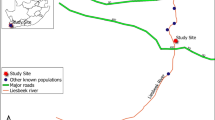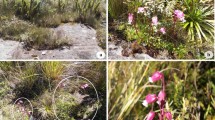Abstract
Introduced plants become decoupled from their usual pollinators and by relying on resident pollinator species or other reproductive strategies become established in new areas, spread and, eventually, invade. Here, using breeding system experiments, we studied the reproductive biology of the bird-pollinated South American species Nicotiana glauca across native and non-native areas, both inside and outside the range of flower-visiting birds. In the native range, where the species is visited by hummingbirds, open cross-pollinated flowers set as many seeds and almost as many fruits as open pollination controls, suggesting that pollinators make a major contribution to reproductive success. In South Africa, the flowers were pollinated by sunbirds which, although less efficiently, also contributed to N. glauca reproduction, replacing hummingbirds. In contrast, in Mallorca, where nectar feeding birds are absent, fruit production in open cross-pollinated flowers was near zero, and significantly lower than in open pollination controls, suggesting that reproduction is almost entirely by autonomous self-pollination. Hand-pollination experiments showed that the species is self-compatible throughout its range. Pollinator exclusion experiment showed that N. glauca relies on self-pollination only in pollinator poor areas, where plants have a much higher capacity for autonomous self-pollination than elsewhere. A reduction in anther-stigma distance does not seem to account the higher self-pollination capacity in the non-native environment without pollinators. Despite probable evolutionary adaptation, and flexibility in pollinator association and mating system, seed production in the introduced range was somewhat pollen limited, suggesting that the mismatch between N. glauca and its novel pollination environment might retard invasion.




Similar content being viewed by others
References
Amsellem L, Noyer J-L, Hossaert-McKey M (2001) Evidence for a switch in the reproductive biology of Rubus alceifolius (Rosaceae) towards apomixis, between its native range and its area of introduction. Am J Bot 88:2243–2251. https://doi.org/10.2307/3558386
Baker HG (1955) Self-compatibility and establishment after “long-distance” dispersal. Evolution 9:347–349. https://doi.org/10.1111/j.1558-5646.1955.tb01544.x
Baker HG (1974) The evolution of weeds. Annu Rev Ecol Syst 5:1–24. https://doi.org/10.1146/annurev.es.05.110174.000245
Barrett SC (2011) Why reproductive systems matter for the invasion biology of plants. Fifty years of invasion ecology: the legacy of Charles Elton 1:195–210
Barrett SCH, Colautti RI, Eckert CG (2008) Plant reproductive systems and evolution during biological invasion. Mol Ecol 17:373–383. https://doi.org/10.1111/j.1365-294X.2007.03503.x
Barthell JF, Randall JM, Thorp RW, Wenner AM (2001) Promotion of seed set in yellow star-thistle by honey bees: evidence of an invasive mutualism. Ecol Appl 11:1870–1883. https://doi.org/10.1890/1051-0761(2001)011%5b1870:POSSIY%5d2.0.CO;2
Bartomeus I, Vilà M (2009) Breeding system and pollen limitation in two supergeneralist alien plants invading Mediterranean shrublands. Aust J Bot 57:109–115. https://doi.org/10.1071/BT08169
Bates D, Kliegl R, Vasishth S, Baayen H (2015) Parsimonious mixed models. arXiv preprint arXiv:150604967
Bossdorf O, Auge H, Lafuma L et al (2005) Phenotypic and genetic differentiation between native and introduced plant populations. Oecologia 144:1–11. https://doi.org/10.1007/s00442-005-0070-z
Bromilow C (2001) Revised edition, First impression. Problem plants of South Africa. Briza Publications, Pretoria
Brown JS, Eckert CG (2005) Evolutionary increase in sexual and clonal reproductive capacity during biological invasion in an aquatic plant Butomus umbellatus (Butomaceae). Am J Bot 92:495–502. https://doi.org/10.3732/ajb.92.3.495
Burns JH, Ashman T-L, Steets JA et al (2011) A phylogenetically controlled analysis of the roles of reproductive traits in plant invasions. Oecologia 166:1009–1017. https://doi.org/10.1007/s00442-011-1929-9
Cronk QCB, Fuller JL (1995) Invasive plants: the threat to natural ecosystems worldwide. Chapman & Hall, London
Davis HG, Taylor CM, Lambrinos JG, Strong DR (2004) Pollen limitation causes an Allee effect in a wind-pollinated invasive grass (Spartina alterniflora). Proc Natl Acad Sci 101:13804–13807
Dlugosch KM, Parker IM (2008) Founding events in species invasions: genetic variation, adaptive evolution, and the role of multiple introductions. Mol Ecol 17:431–449. https://doi.org/10.1111/j.1365-294X.2007.03538.x
Eckert CG, Schaefer A (1998) Does self-pollination provide reproductive Assurance in Aquilegia canadensis (Ranunculaceae)? Am J Bot 85:919–924. https://doi.org/10.2307/2446357
Galetto L, Bernardello L (1993) Nectar secretion pattern and removal effects in three species of Solanaceae. Can J Bot 71:1394–1398
Geerts S, Pauw A (2009a) African sunbirds hover to pollinate an invasive hummingbird-pollinated plant. Oikos 118:573–579. https://doi.org/10.1111/j.1600-0706.2008.17167.x
Geerts S, Pauw A (2009b) Hyper-specialization for long-billed bird pollination in a guild of South African plants: the malachite sunbird pollination syndrome. S Afr J Bot 75:699–706. https://doi.org/10.1016/j.sajb.2009.08.001
Global Invasive Species Database (2005) ISSG database: ecology of Nicotiana glauca. http://issg.org/database/species/ecology.asp?si=1453&fr=1&sts=sss&lang=EN. Accessed 25 June 2017
Goodell K, McKinney AM, Lin C (2010) Pollen limitation and local habitat-dependent pollinator interactions in the invasive shrub Lonicera maackii. Int J Plant Sci 171:63–72. https://doi.org/10.1086/647921
Goodspeed TH (1954) The genus Nicotiana; origins, relationships and evolution of its species in the light of their distribution, morphology and cytogenetics. Chronica Botanica Company, Leyden
Grossenbacher DL, Brandvain Y, Auld JR et al (2017) Self-compatibility is over-represented on islands. New Phytol 215:469–478. https://doi.org/10.1111/nph.14534
Hierro JL, Maron JL, Callaway RM (2005) A biogeographical approach to plant invasions: the importance of studying exotics in their introduced and native range. J Ecol 93:5–15. https://doi.org/10.1111/j.0022-0477.2004.00953.x
Karron JD, Jackson RT, Thumser NN, Schlicht SL (1997) Outcrossing rates of individual Mimulus ringens genets are correlated with anther–stigma separation. Heredity 79:365–370. https://doi.org/10.1038/hdy.1997.169
Knight TM, Steets JA, Vamosi JC et al (2005) Pollen limitation of plant reproduction: pattern and process. Annu Rev Ecol Evol Syst 36:467–497. https://doi.org/10.1146/annurev.ecolsys.36.102403.115320
Liu H, Pemberton RW, Stiling P (2006) Native and introduced pollinators promote a self-incompatible invasive woody vine (Paederia foetida L) in Florida. J Torrey Bot Soc 133:304–311. https://doi.org/10.3159/1095-5674(2006)133%5b304:NAIPPA%5d2.0.CO;2
Lloyd DG, Schoen DJ (1992) Self- and cross-fertilization in plants. I. Functional dimensions. Int J Plant Sci 153:358–369. https://doi.org/10.1086/297040
López-García MC, Maillet J (2005) Biological characteristics of an invasive south African species. Biol Invasions 7:181–194. https://doi.org/10.1007/s10530-004-8978-5
Malo JE, Baonza J (2002) Are there predictable clines in plant–pollinator interactions along altitudinal gradients? The example of Cytisus scoparius (L.) Link in the Sierra de Guadarrama (Central Spain). Divers Distrib 8:365–371
Maruyama PK, Vizentin-Bugoni J, Sonne J et al (2016) The integration of alien plants in mutualistic plant–hummingbird networks across the Americas: the importance of species traits and insularity. Divers Distrib 22:672–681
Medel R, Valiente A, Botto-Mahan C et al (2007) The influence of insects and hummingbirds on the geographical variation of the flower phenotype in Mimulus luteus. Ecography 30:812–818
Montero-Castaño A, Vilà M, Ortiz-Sánchez FJ (2014) Pollination ecology of a plant in its native and introduced areas. Acta Oecol 56:1–9. https://doi.org/10.1016/j.actao.2014.01.001
Moodley D, Geerts S, Richardson DM, Wilson JRU (2016) The importance of pollinators and autonomous self-fertilisation in the early stages of plant invasions: Banksia and Hakea (Proteaceae) as case studies. Plant Biol 18:124–131. https://doi.org/10.1111/plb.12334
Moragues E, Rita J (2005) Els vegetals introduïts a les Illes Balears. Govern de les Illes Balears, Palma de Mallorca
Motten AF, Stone JL (2000) Heritability of stigma position and the effect of stigma-anther separation on outcrossing in a predominantly self-fertilizing weed, Datura stramonium (Solanaceae). Am J Bot 87:339–347. https://doi.org/10.2307/2656629
Nattero J, Cocucci AA (2007) Geographical variation in floral traits of the tree tobacco in relation to its hummingbird pollinator fauna. Biol J Linn Soc 90:657–667. https://doi.org/10.1111/j.1095-8312.2007.00756.x
Nattero J, Sérsic AN, Cocucci AA (2010) Patterns of contemporary phenotypic selection and flower integration in the hummingbird-pollinated Nicotiana glauca between populations with different flower–pollinator combinations. Oikos 119:852–863. https://doi.org/10.1111/j.1600-0706.2009.17766.x
Nattero J, Sérsic AN, Cocucci AA (2011) Geographic variation of floral traits in Nicotiana glauca: relationships with biotic and abiotic factors. Acta Oecol 37:503–511. https://doi.org/10.1016/j.actao.2011.07.001
Oduor AMO (2013) Evolutionary responses of native plant species to invasive plants: a review. New Phytol 200:986–992. https://doi.org/10.1111/nph.12429
Ollerton J, Winfree R, Tarrant S (2011) How many flowering plants are pollinated by animals? Oikos 120:321–326. https://doi.org/10.1111/j.1600-0706.2010.18644.x
Ollerton J, Watts S, Connerty S et al (2012) Pollination ecology of the invasive tree tobacco Nicotiana glauca: comparisons across native and non-native ranges. J Pollinat Ecol 9:85–95
Pannell JR, Auld JR, Brandvain Y et al (2015) The scope of Baker’s law. New Phytol 208:656–667. https://doi.org/10.1111/nph.13539
Parker IM (1997) Pollinator limitation of Cytisus scoparius (Scotch broom), an invasive exotic shrub. Ecology 78:1457–1470. https://doi.org/10.1890/0012-9658(1997)078%5b1457:PLOCSS%5d2.0.CO;2
Parker IM (2004) Mating patterns and rates of biological invasion. Proc Natl Acad Sci 101:13695–13696
Parker IM, Haubensak KA (2002) Comparative pollinator limitation of two non-native shrubs: do mutualisms influence invasions? Oecologia 130:250–258. https://doi.org/10.1007/s004420100799
Petanidou T, Godfree RC, Song DS et al (2012) Self-compatibility and plant invasiveness: comparing species in native and invasive ranges. Perspect Plant Ecol Evolut Syst 14:3–12. https://doi.org/10.1016/j.ppees.2011.08.003
Petanidou T, Price MV, Bronstein JL et al (2018) Pollination and reproduction of an invasive plant inside and outside its ancestral range. Acta Oecol 89:11–20. https://doi.org/10.1016/j.actao.2018.03.008
Pyke GH (1981) Why hummingbirds hover and honeyeaters perch. Anim Behav 29(3):861–867
Pyšek P, Jarošík V, Chytrý M et al (2011) Successful invaders co-opt pollinators of native flora and accumulate insect pollinators with increasing residence time. Ecol Monogr 81:277–293. https://doi.org/10.1890/10-0630.1
Pyšek P, Jarošík V, Hulme PE et al (2012) A global assessment of invasive plant impacts on resident species, communities and ecosystems: the interaction of impact measures, invading species’ traits and environment. Global Change Biol 18:1725–1737. https://doi.org/10.1111/j.1365-2486.2011.02636.x
Razanajatovo M, Maurel N, Dawson W et al (2016) Plants capable of selfing are more likely to become naturalized. Nat Commun 7:13313. https://doi.org/10.1038/ncomms13313
Richardson DM, Allsopp N, D’antonio CM et al (2000a) Plant invasions—the role of mutualisms. Biol Rev 75:65–93
Richardson DM, Pyšek P, Rejmánek M et al (2000b) Naturalization and invasion of alien plants: concepts and definitions. Divers Distrib 6:93–107. https://doi.org/10.1046/j.1472-4642.2000.00083.x
Rodger JG, van Kleunen M, Johnson SD (2010) Does specialized pollination impede plant invasions? Int J Plant Sci 171:382–391. https://doi.org/10.1086/651226
Schueller SK (2004) Self-pollination in island and mainland populations of the introduced hummingbird-pollinated plant, Nicotiana glauca (Solanaceae). Am J Bot 91:672–681. https://doi.org/10.3732/ajb.91.5.672
Suehs CM, Affre L, Medail F (2005) Unexpected insularity effects in invasive plant mating systems: the case of Carpobrotus (Aizoaceae) taxa in the Mediterranean Basin. Biol J Linn Soc 85:65–79. https://doi.org/10.1111/j.1095-8312.2005.00473.x
Takebayashi N, Delph LF (2000) An association between a floral trait and inbreeding depression. Evolution 54:840–846. https://doi.org/10.1111/j.0014-3820.2000.tb00084.x
Team RC (2017) R: a language and environment for statistical computing (version 3.4. 2) [Computer software]. R Foundation for Statistical Computing, Vienna
van Kleunen M, Johnson SD (2005) Testing for ecological and genetic Allee effects in the invasive shrub Senna didymobotrya (Fabaceae). Am J Bot 92:1124–1130. https://doi.org/10.3732/ajb.92.7.1124
van Kleunen M, Manning JC, Pasqualetto V, Johnson SD (2008) Phylogenetically independent associations between autonomous self-fertilization and plant invasiveness. Am Nat 171:195–201. https://doi.org/10.1086/525057
van Kleunen M, Bossdorf O, Dawson W (2018) The ecology and evolution of alien plants. Annu Rev Ecol Evol Syst 49:25–47. https://doi.org/10.1146/annurev-ecolsys-110617-062654
Vilà M, Bartomeus I, Dietzsch AC et al (2009) Invasive plant integration into native plant–pollinator networks across Europe. Proc R Soc B Biol Sci 276:3887–3893
Ward M, Johnson SD, Zalucki MP (2012) Modes of reproduction in three invasive milkweeds are consistent with Baker’s Rule. Biol Invasions 14:1237–1250. https://doi.org/10.1007/s10530-011-0152-2
Westerkamp C (1990) Bird-flowers—hovering versus perching exploitation. Botanical Acta 103:366–371
Zapata TR, Arroyo MTK (1978) Plant reproductive ecology of a secondary deciduous tropical forest in Venezuela. Biotropica 10:221. https://doi.org/10.2307/2387907
Zuur A, Ieno EN, Walker N et al (2009) Mixed effects models and extensions in ecology with R. Springer, Berlin
Acknowledgements
We thank M.C. Baranzelli, G. Bertone, A. Bonino, R. Castro, A. Coetzee, M.C. Díaz-Vélez, M.C. Maubecin, X. Rotllán Puig, F. Sazatornil, C. Tur, and C. Vignolo Pena for assistance in the field work, and C. Vignolo Pena for assistance in the lab. Funding for this research was provided by the National Research Council of Argentina (CONICET), the National Ministry of Science and Technology of Argentina, the Department of Science and Technology of South Africa and the Spanish Research Council (CSIC).
Author information
Authors and Affiliations
Corresponding author
Additional information
Publisher's Note
Springer Nature remains neutral with regard to jurisdictional claims in published maps and institutional affiliations.
Rights and permissions
About this article
Cite this article
Issaly, E.A., Sérsic, A.N., Pauw, A. et al. Reproductive ecology of the bird-pollinated Nicotiana glauca across native and introduced ranges with contrasting pollination environments. Biol Invasions 22, 485–498 (2020). https://doi.org/10.1007/s10530-019-02104-8
Received:
Accepted:
Published:
Issue Date:
DOI: https://doi.org/10.1007/s10530-019-02104-8




